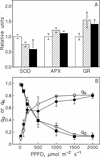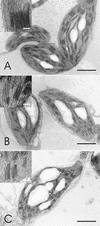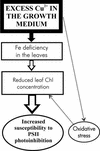Excess copper predisposes photosystem II to photoinhibition in vivo by outcompeting iron and causing decrease in leaf chlorophyll
- PMID: 12114589
- PMCID: PMC166529
- DOI: 10.1104/pp.004788
Excess copper predisposes photosystem II to photoinhibition in vivo by outcompeting iron and causing decrease in leaf chlorophyll
Abstract
Photoinhibition of photosystem II was studied in vivo with bean (Phaseolus vulgaris) plants grown in the presence of 0.3 (control), 4, or 15 microM Cu(2+). Although photoinhibition, measured in the presence of lincomycin to block concurrent recovery, is faster in leaves of Cu(2+)-treated plants than in control leaves, thylakoids isolated from Cu-treated plants did not show high sensitivity to photoinhibition. Direct effects of excess Cu(2+) on chloroplast metabolism are actually unlikely, because the Cu concentration of chloroplasts of Cu-treated plants was lower than that of their leaves. Excess Cu in the growth medium did not cause severe oxidative stress, collapse of antioxidative defenses, or loss of photoprotection. Thus, these hypothetical effects can be eliminated as causes for Cu-enhanced photoinhibition in intact leaves. However, Cu treatment lowered the leaf chlorophyll (Chl) concentration and reduced the thylakoid membrane network. The loss of Chl and sensitivity to photoinhibition could be overcome by adding excess Fe together with excess Cu to the growth medium. The addition of Fe lowered the Cu(2+) concentration of the leaves, suggesting that Cu outcompetes Fe in Fe uptake. We suggest that the reduction of leaf Chl concentration, caused by the Cu-induced iron deficiency, causes the high photosensitivity of photosystem II in Cu(2+)-treated plants. A causal relationship between the susceptibility to photoinhibition and the leaf optical density was established in several plant species. Plant species adapted to high-light habitats apparently benefit from thick leaves because the rate of photoinhibition is directly proportional to light intensity, but photosynthesis becomes saturated by moderate light.
Figures






Similar articles
-
Primary sites of ozone-induced perturbations of photosynthesis in leaves: identification and characterization in Phaseolus vulgaris using high resolution chlorophyll fluorescence imaging.J Exp Bot. 2001 Aug;52(361):1689-96. J Exp Bot. 2001. PMID: 11479334
-
Remodeling of the major light-harvesting antenna protein of PSII protects the young leaves of barley (Hordeum vulgare L.) from photoinhibition under prolonged iron deficiency.Plant Cell Physiol. 2010 Dec;51(12):2013-30. doi: 10.1093/pcp/pcq160. Epub 2010 Oct 26. Plant Cell Physiol. 2010. PMID: 20980268
-
ZEBRA-NECROSIS, a thylakoid-bound protein, is critical for the photoprotection of developing chloroplasts during early leaf development.Plant J. 2010 May 1;62(4):713-25. doi: 10.1111/j.1365-313X.2010.04183.x. Epub 2010 Feb 26. Plant J. 2010. PMID: 20202171
-
Photosynthetic carbon reduction and carbon oxidation cycles are the main electron sinks for photosystem II activity during a mild drought.Ann Bot. 2002 Jun;89 Spec No(7):887-94. doi: 10.1093/aob/mcf064. Ann Bot. 2002. PMID: 12102514 Free PMC article. Review.
-
Photosynthetic light reactions--an adjustable hub in basic production and plant immunity signaling.Plant Physiol Biochem. 2014 Aug;81:128-34. doi: 10.1016/j.plaphy.2013.12.004. Epub 2013 Dec 14. Plant Physiol Biochem. 2014. PMID: 24361390 Review.
Cited by
-
The effects of excess copper on antioxidative enzymes, lipid peroxidation, proline, chlorophyll, and concentration of Mn, Fe, and Cu in Astragalus neo-mobayenii.ScientificWorldJournal. 2012;2012:615670. doi: 10.1100/2012/615670. Epub 2012 Nov 20. ScientificWorldJournal. 2012. PMID: 23213292 Free PMC article.
-
The effect of excess copper on growth and physiology of important food crops: a review.Environ Sci Pollut Res Int. 2015 Jun;22(11):8148-62. doi: 10.1007/s11356-015-4496-5. Epub 2015 Apr 15. Environ Sci Pollut Res Int. 2015. PMID: 25874438 Review.
-
Bacillus sp. extract used to fabricate ZnO nanoparticles for their antagonist effect against phytopathogens.Biometals. 2022 Dec;35(6):1255-1269. doi: 10.1007/s10534-022-00440-2. Epub 2022 Sep 8. Biometals. 2022. PMID: 36075996
-
BcGR1.1, a Cytoplasmic Localized Glutathione Reductase, Enhanced Tolerance to Copper Stress in Arabidopsis thaliana.Antioxidants (Basel). 2022 Feb 15;11(2):389. doi: 10.3390/antiox11020389. Antioxidants (Basel). 2022. PMID: 35204271 Free PMC article.
-
Copper microlocalisation and changes in leaf morphology, chloroplast ultrastructure and antioxidative response in white lupin and soybean grown in copper excess.J Plant Res. 2014;127(1):119-29. doi: 10.1007/s10265-013-0583-1. Epub 2013 Aug 27. J Plant Res. 2014. PMID: 23979008
References
-
- Abadía A, Lemoine Y, Trémolières A, Ambard-Bretteville F, Rémy R. Iron deficiency in pea: effects on pigment, lipid and pigment-protein complex composition of thylakoids. Plant Physiol Biochem. 1989;27:679–687.
-
- Abadía J, Morales F, Abadía A. Photosystem II efficiency in low chlorophyll, iron-deficient leaves. Plant Soil. 2000;215:183–192.
-
- Alscher RG. Biosynthesis and antioxidant function of glutathione in plants. Physiol Plant. 1989;77:457–464.
-
- Arellano JB, Lázaro JJ, López GJ, Báron M. The donor side of PSII as copper-inhibitory site: fluorescence and polarographic studies. Photosynth Res. 1995;45:127–134. - PubMed
Publication types
MeSH terms
Substances
LinkOut - more resources
Full Text Sources

